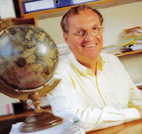Groups and clusters of galaxies are presently important objects of study, because they raise fundamental problems concerning structuring processes in the Universe. They comprise stellar matter, gas and unseen matter. The physical processes accounting for the evolution and interactions of these various components in the evolving Universe are complex.
|
Florence Durret, Daniel Gerbal |
Welcome address |
 |
|
Andrea Biviano's historical talk and Simon White's talk will be the starting point of a lively conference, with stimulating discussions and possibly emerging collaborations between you. Let me just say now a few words about our institute and its immediate future. IAP was one of the first CNRS laboratories, built in 1937. It strongly contributed to the development of astrophysics in France. Our ambition was to belong to the international network of the most dynamic astrophysical laboratories. Our ministerial authorities are convinced that we shall maintain in astronomy such a pole of excellencies in Paris. They gave the kick off signal to engage a new development plan called IAP 2000+. In January 2001, we will be associated with the famous Pierre and Marie Curie University that will contribute to this effort hand in hand with the French CNRS. We look forward to a rapid upgrading of the IAP building with new meeting rooms, teaching rooms, cafeteria, etc. plus 24 new offices for scientists. An architectural cabinet is presently working on a new design for IAP. I cross my fingers for a continuation of this funding until the end of this project. This action is indeed taken to promote a new scientific strategy: I hope that in the next decade, IAP will be already experimenting a new foundation, but still with the former spirit of continuous evolution for even more creativity. The institute is small but wants to conjugate the cultural appeal of our old historical capital with the strong attractivity of a leading laboratory. We currently need your visit and help to succeed. Bring us your ideas and remarks. We need them to progress because we can learn a lot from all of you
|
|
Go to
|
list of participants |